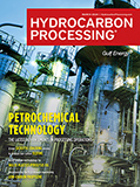Piping
Reliability: When to consider liquid-ring compressors
Liquid-ring compressors (FIG. 1) use the centrifugal whirling of a sealing liquid to create a series of piston-like water columns to trap gas or vapor between the impeller cells of a rotor installed eccentric to its casing.
Business Trends: Non-OEM parts—Buyer beware
What is the harm in wearing a knock-off Rolex watch?
Investigations of high pressure drop observed in ASU columns
The measured pressure drop of columns in air separation units (ASUs) is often reported as being higher than the predicted pressure drop.
HP Flashback: Excerpts from the 1960s: Petrochemicals rise in prominence and new know-how in refining processes
Petrochemicals rise in prominence and new know-how in refining processes
Investigation and diagnosis of startup foaming issues at a new tail gas treater
In May 2021, Phillips 66 started up a new methyl diethanolamine (MDEA)-based tail gas unit at its Belle Chasse, Louisiana, refinery.
HP Flashback: Operations expand and technologies advance during global conflict: Excerpts from the 1940s
This articles details several case studies on the use of x-ray technology for inspection purposes. This includes for the inspection of casings, forgings and welded structures, among others.
Piping interface type selection
Most oil and gas process plant projects involve multiple work packages executed by different lump sum turnkey (LSTK) contractors executing work within their own package, with a final piping interface connection at an agreed boundary limit to accomplish the interface joint between two parties and successfully close the piping interface.
HP Flashback: Operations, processes and safety evolve and advance: Excerpts from the 1930s
The following is a mixture of technical articles, columns and headlines published in the 1930s by <i>The Refiner and Natural Gasoline Manufacturer</i>, the forerunner to <i>Hydrocarbon Processing</i>.
Upkeep down the pipe: Plant shutdowns and water treatment
The maintenance checklist for a plant shutdown can sometimes look intimidating and, in the face of a short timeline, unnerving.
Are hot pipes and equipment surfaces ignition sources in the HPI?
Most international and national standards used in the hydrocarbon processing industry (HPI) for conducting hazardous area classification do not provide any guidance or recommendation for non-electrical equipment, such as hot pipe and equipment surfaces, that can act as ignition sources.

- WestJet buys first Canadian-supplied SAF by Shell Aviation 4/23
- Technip Energies selected by Viridor to perform FEED on the Runcorn energy-from-waste carbon capture project in the UK 4/23
- SINOPEC completes its involvement in Kazakhstan's polyethylene project 4/23
- Neste premieres at Chinaplas: showcasing possibilities of bio-based and recycled materials for plastics 4/23
- Russia's oil refining near 11-month low 4/23
- Haiti fuel terminal operations halted as gangs seize trucks 4/23




